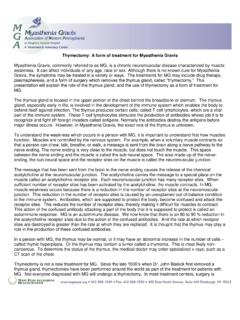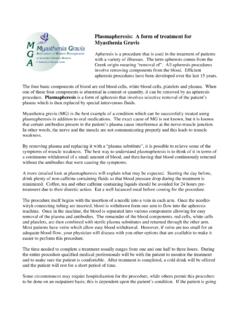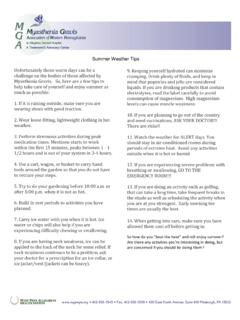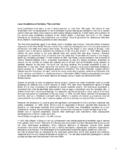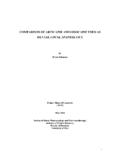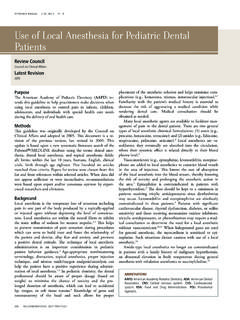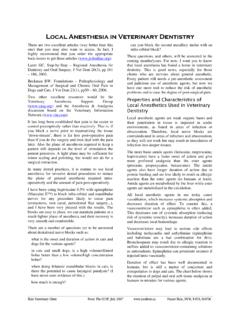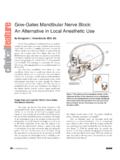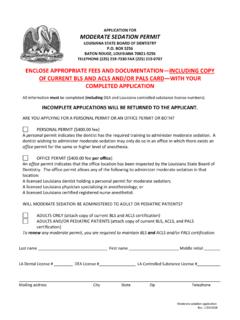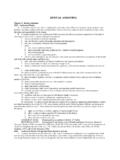Transcription of Dentristy and Myasthenia GravisLH
1 dentistry AND Myasthenia GRAVIS The authors prepared this article for MG patients to give to their dentist. It is a compact but comprehensive review of the illness, and covers various aspects which are unique to the appropriate dental care of the myasthenic patient. dentistry can be a part of normal health care for the myasthenic and should not be feared or avoided. The objective of this article is to give both the dentist and the myasthenic a basis for understanding and communication that will result in good dental health and the prevention of future major problems. BASIC PROBLEM: Myasthenia gravis (MG) presents as a neuromuscular disorder characterized by progressive weakness and fatigue of the voluntary muscles and made worse with exercise and relieved by rest.
2 MG is believed to be an autoimmune phenomenon with a reduction of acetylcholine (Ach) receptors at the neuromuscular junction. Muscles contract when Ach from the motor nerve axon vesicles interact with the Ach receptor of the postsynaptic area on the muscle, causing depolarization and contraction of muscle. Ach is hydrolyzed by acetylcholinesterase (Ach E) after the depolarization. A process, activity, or drug that interferes with any of these steps will result in a decrease in response of muscle to stimulations resulting in weakness. Most myasthenics have elevated amounts of antibodies that bind to Ach receptors. Therefore, a reduction of Ach receptors is believed to be the basic problem in MG. The dentist and staff should first understand that the myasthenic does not have a contagious disease and is not a threat to staff or other patients.
3 CLINICAL FINDINGS: MG most often affects other muscles innervated by the cranial nerves, in women more frequently than men (3:2). Any age group can be affected but is notable for women in the 20s and 30s and men in the 50s and 60s. Many, but not all, myasthenics experience eye problems (ocular muscles) such as droopy eyelids (ptosis), double vision (diplopia), blurry vision, and weakness of eyelid closure. Some may experience difficulty swallowing and chewing and slurred speech (laryngeal and pharangeal muscles) and weak neck (head holding) muscles. There may be weakness or abnormal fatigue of the proximal muscles of the arms (especially) and legs. Although about 16% of myasthenics have symptoms restricted to the eyes, the majority have involvement of oropharyngeal and limb muscles.
4 Partial remissions sometime occur. Some (5%) myasthenics have thyroid dysfunction. Weakness will often increase with hot weather, fever, systemic illness, infections, exercise, a hot bath, stress, menstrual cycle, and drugs that display a neuromuscular blocking effect. Myasthenics often experience frustrations in getting diagnosed with fluctuating symptoms that are dismissed as a psychiatric problem. Diagnosis is eventually made with the demonstration of: fatigue on muscle testing; improvement after giving an anticholinesterase drug; repetitive nerve stimulation tests; and antibodies to the acetylcholine receptor. MEDICAL TREATMENT: The standard anticholinesterase drug for MG is Mestinon (pyridostigmine) although there are several others.
5 Few patients experience complete relief and may find that medication requirements vary during the day or from day to day. The most common side effects of inhibitors are gastrointestinal. Some patients may also have an increase in bronchial secretions, bronchospasm, oropharyngeal weakness, or respiratory insufficiency. Some MG patients take corticosteroids (prednisone) and commonly have had the thymus gland removed (thyme tome), sometimes including a thymoma. For severe situations, plasma exchange (plasmapaheresis) may give temporary improvement to avoid respiratory assistance. DENTAL TREATMENT: The controlled myasthenic is able to tolerate productive dental sessions with some modest accommodations from the dentist (and staff) and with planning and cooperation from the patient.
6 Appointments: Usually morning appointments will work best, depending upon when the patient is at his/her best. It will help for the patient to take medication so there will be optimal oral and neck strength for the dental appointment. Patient and the dental staff should cooperate on appointment scheduling and patient should plan on being rested to the greatest extent possible so there is less chance of needing to cancel the session. The patient should allow time to arrive and rest a bit. In hot weather it will help to arrive and refresh in the air conditioned office. The myasthenic is more susceptible to infection, especially if taking immuno-suppressant drugs or prednisone. Bring the patient back to a dental chair to relax a few minutes rather than sitting in the waiting room closely with others.
7 The patient can take comfort in knowing that modern dentistry embraces universal precautions . Dentists and assistants routinely wear gloves and masks before starting intraoral procedures. All equipment and supplies should be previously set up and organized so the procedure can be efficient and productive. Appointments should usually avoid long sessions. For example, if several crowns were being prepared, temporary coverage should be made and impressions deferred to another appointment, if the patient becomes fatigued. History: The amount of treatment, chair position, and head support can be planned based on the patient s problems, if any, with swallowing, holding head up, breathing, or choking. Some may have no problem at all, others a severe problem.
8 Severe or uncontrolled cases and those on life support will usually be best treated through hospital dentistry programs or special patient care programs in larger health centers and dental schools. Chair Position: Usually it is more difficult for the myasthenic to lie way back. It may help to be more upright to avoid closing the throat or regurgitating fluids. The dentist and patient need to find a compromise that can be tolerated by the patient yet give adequate access to the mouth to permit proper and safe dental treatment. The patient may wish to try a small neck pillow to support the head. However, most modern dental chairs are contoured and have adjustable cup-shaped head rests that support the head. Procedures: A chairside assistant is highly recommended using a good oral evacuation suction and a hand-held, self-directed, evacuation ejector to remove saliva and water.
9 Rubber dam tooth isolation is very helpful whenever possible. The tooth is on the dentist s side and the patient can move the tongue and saliva ejector around on the other side without worry about choking or aspirating. Root canals can be done as well as restorations and crowns. Use a rubber mouth prop if it is difficult to keep the jaw open but periodically remove it for a rest break and don t over-stretch the mouth. (The dentist and assistant should try a mouth prop themselves for a more realistic concept of limits.) A pediatric-sized handpiece may be used for posterior areas with limited access. Attitudes: Everyone will do better trying to accommodate the situation. Positive reinforcement gets most patients to go the extra mile and try to tolerate the procedure rather than intolerance, rushing or impatience.
10 Dentist and patient should cooperate on moderating costs. Most dentists experience high overhead costs. But the myasthenic does also, often having major medical costs and needing special transportation or facing extra visits to accomplish a procedure. Anesthetics and Medications: Local anesthesia is much preferable to general anesthesia for the myasthenic. Fortunately, most routine dentistry is done with local anesthesia. There is no contra-indication to nitrous-oxide with oxygen for light sedation. Lidocaine ( xylocaine and other brands) may exacerbate MG intravenously but should not be ruled out locally if needed. Mepivocaine ( carbocaine ) has few side effects, has shorter duration and is a good first choice. Use anesthetic vasoconstrictors if needed to get adequately lasting and profound anesthesia.




